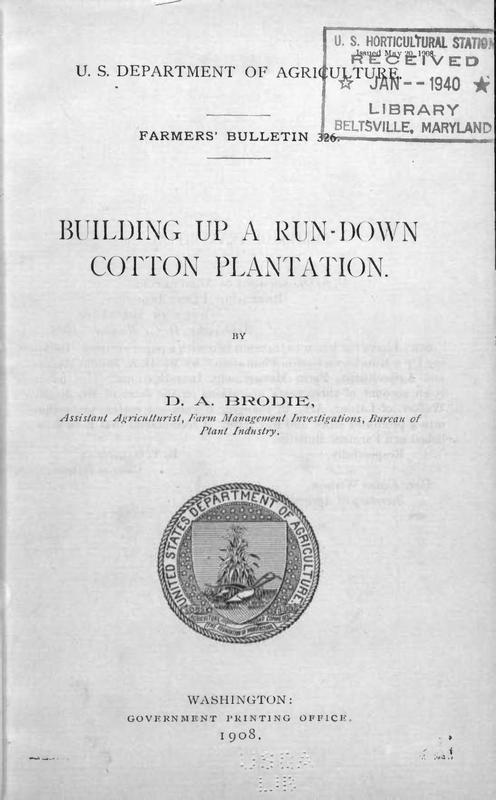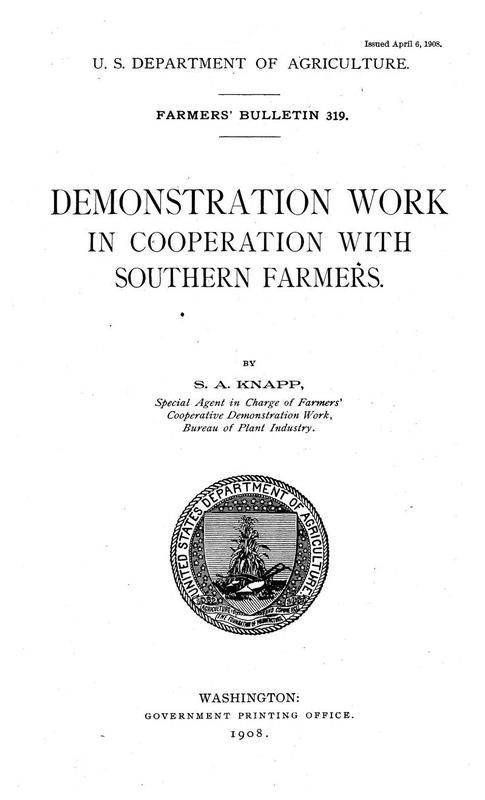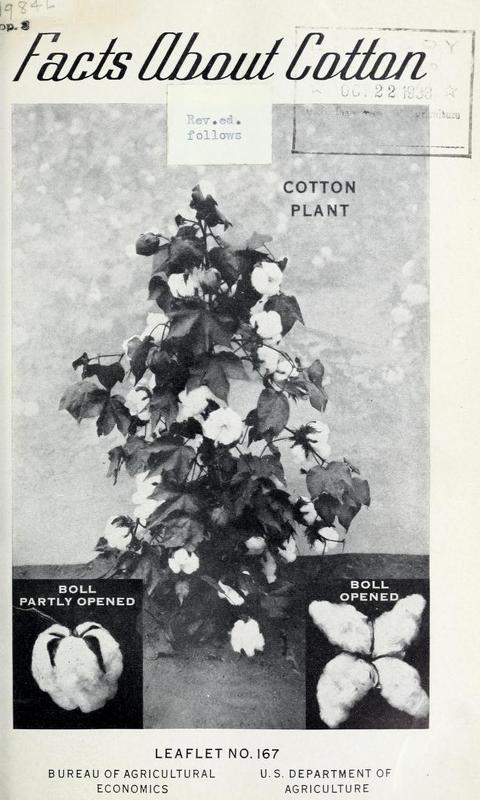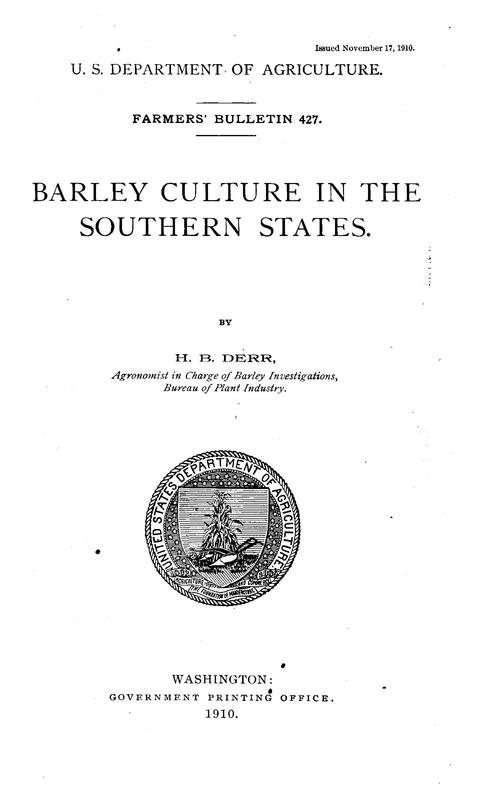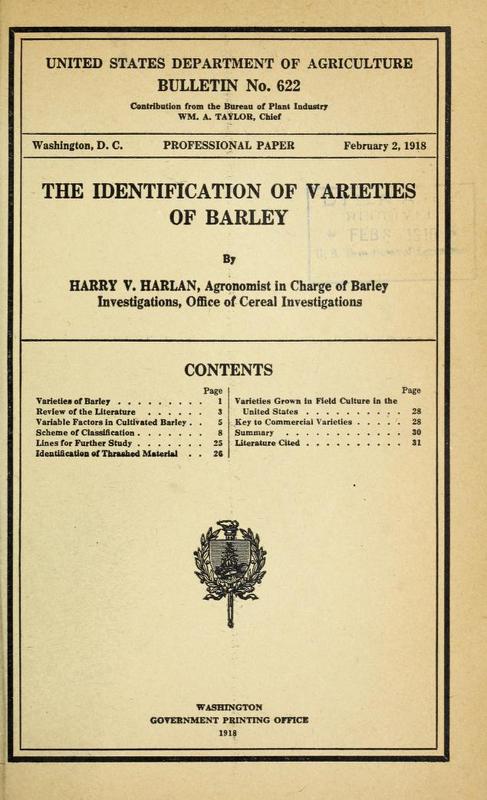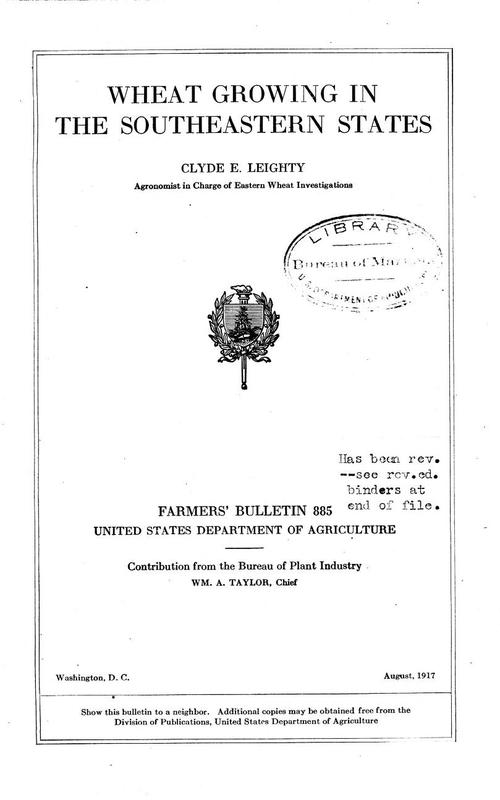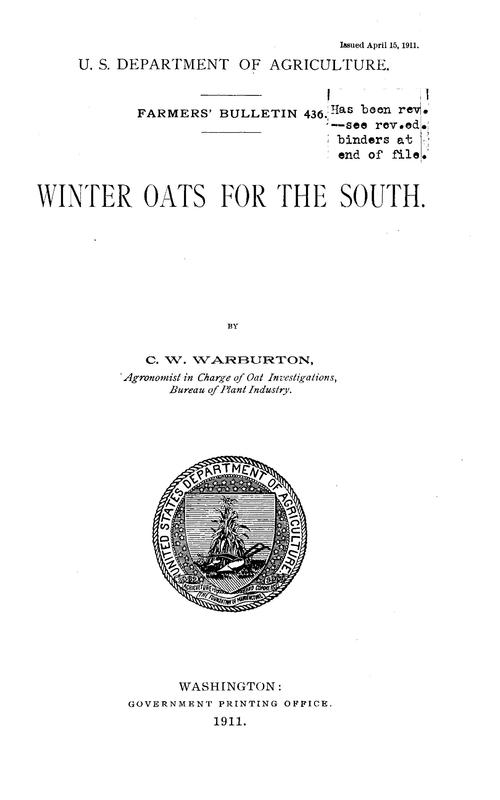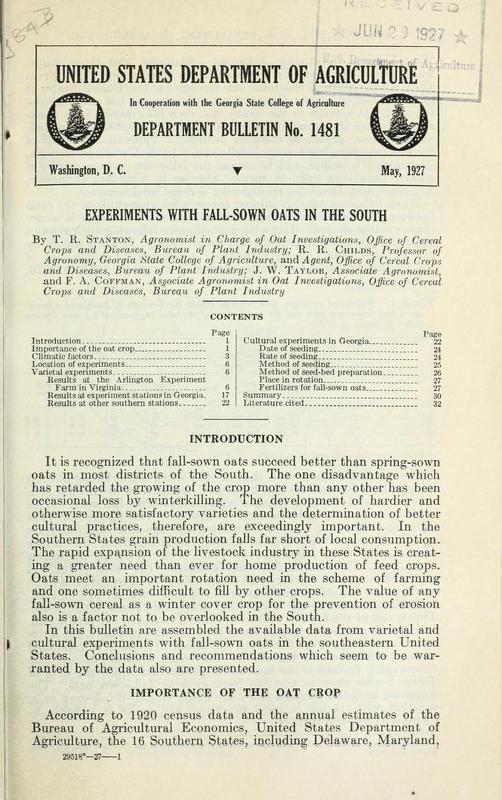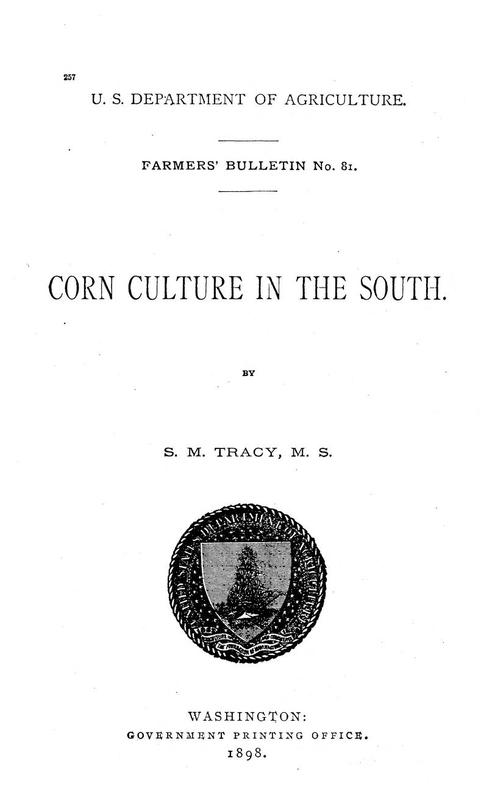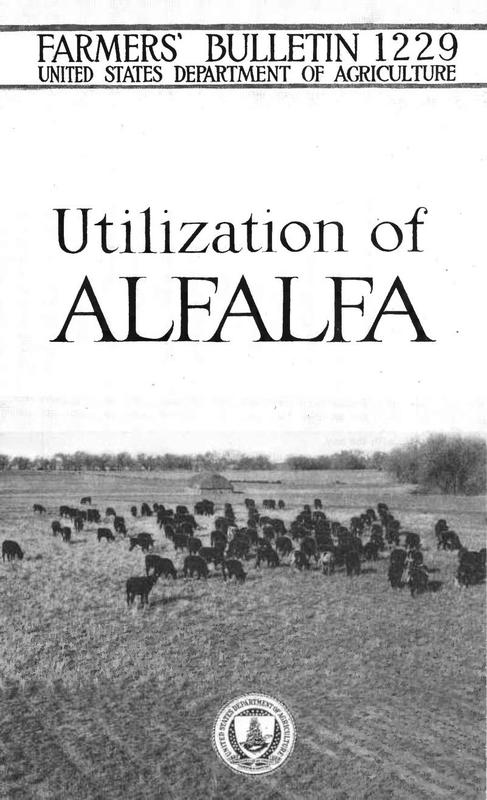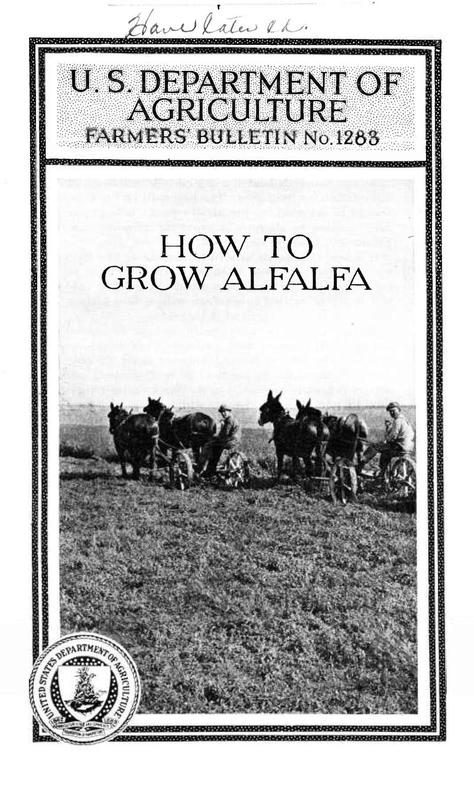USDA Historical Publications on Crop Development: Other Crops
The U.S. Department of Agriculture created many publications that described the essential issues and requirements for different forms of crop development.
Here is a small sample of historical USDA documents that addressed issues of growing and developing the other crops for the small farmer addressed by Carver: Cotton, Small Grains, Corn, Alfalfa, and Plums, created around the time of Carver's bulletins.
(Click any image in this exhibit to get more information, including access to full text)
Cotton
"This bulletin is an account of the progress made in three years in changing a run-down cotton plantation into a profitable stock and hay farm. The results obtained from the use of cowpeas and other leguminous crops in restoring the fertility of the land have exceeded the expectations of those in charge of the work. Not only have the crops yielded greater returns each year, but all the grain and hay necessary to feed 14 brood mares, 1 jack, 2 driving horses, 1 saddle horse, a varying number of mule colts, a cow and calf, and from 50 to 75 hogs has been raised and a considerable surplus of grain and hay sold each year.
However, it is only fair to state that all of the credit for this increased production is not due to the legumes alone, because at the start an entirely new system of farming was put into operation; modern implements took the place of the old ones, the land was plowed deeper, better drainage established, improved seed introduced, and better methods of cultivation practiced, each doubtless contributing something to the general improvement."
"The Farmers' Cooperative Demonstration Work conducted by the United States Department of Agriculture through the Bureau of Plant Industry was inaugurated under authority of Congress in January, 1904, primarily because of the depredations of the Mexican cotton boll weevil in the State of Texas. By the rapid spread of this pest east and north it had then become evident that it would in time invade all of the cotton-producing States. This occasioned a general alarm among the cotton planters and in the industrial centers of the entire country. For a number of years prior to 1904 the Mexican boll weevil had been steadily encroaching upon the cotton-producing lands of Texas, until it had spread from the Rio Grande to a short distance beyond the eastern boundary of the State and threatened the entire cotton industry of the South. In sections where cotton was the sole cash crop the invasion of the weevil and the consequent loss of the cotton crop brought disaster to every interest and so completely demoralized financial conditions as to produce in some sections a panic.
The cotton crop had been generally produced upon a credit system by securing advances from merchants and bankers. Upon the advent of the boll weevil, confidence in securing a cotton crop was impaired and in some districts almost totally destroyed. The usual advances were either withheld or limited; labor became discontented and sought other sections or other States, and tenant farmers unable to obtain advances removed to noninfested districts, a marked decline in property values resulting.
These circumstances created a demand for immediate relief which appealed to the entire country, as the loss of the cotton crop would be a national calamity. In response to this appeal Congress made an emergency appropriation in January, 1904, which has been continued each year, thus affording opportunity for the growth and enlargement of the work."
"Cotton is the great crop of the South. It is grown on about 2 million farms in the southern part of our country. The average size of the crop is about 13 million bales of cotton lint, each weighing about 500 pounds, and about 6 million tons of cottonseed.
Large quantities of cotton are grown in other countries, too — chiefly India, China, Egypt, Brazil, and the Union of Soviet Socialist Republics. These cottons differ in quality to some extent from those grown in the United States and there is also considerable variation in the varieties and qualities of cotton produced here. Usually about one-half of our crop is used in our own mills. The remainder is exported chiefly to Japan, Great Britain, and the continent of Europe.
The planting of cotton begins in February in the southernmost parts of the Cotton Belt, and moves northward. At the northern edge of the belt and at the higher elevations planting usually is completed in May. As the pictures suggest, the methods of cultivating, harvesting, and handling vary through the Cotton Belt, from rather primitive in some sections, to very modern in others. The crop requires hand work. Usually cotton pickers of all ages are in great demand for picking from August through November. A field of open cotton bolls with pickers along the rows is a characteristic southern scene."
Small Grains
"Barley, although it ranks fourth among the cereals in the United States, is but little cultivated in the South for grain.
As a true awnless barley has been developed the word 'hooded' is proposed for the beardless barleys now grown.
The Tennessee Winter variety is the most profitable barley to grow in the South.
Winter hooded and spring hooded barleys are grown in only a few localities in the South.
The best soils for barley, either for grain or hay, are the fertile loams and clays.
Barley requires nitrogen, phosphoric acid, and potash to perfect the grain crop. The first, which is high priced, can be largely supplied by plowing under clover and cowpeas. This leaves only the cheaper fertilizers to be purchased.
Liming the soil has proved beneficial to barley.
Seed should be carefully selected before seeding to insure a good stand. The skimming process, when properly done, gives excellent results. Seed can be treated for smut in this operation.
The seed bed must be well prepared.
Barley will succeed best after a cultivated crop.
The time of seeding barley is regulated by the locality and elevation. A safe rule in the South is to sow winter barley before sowing winter wheat.
Spring barley to succeed in the South must be sown as early as possible."
"This bulletin has been prepared primarily to meet a widespread demand for a publication on the forms of barley. Although advantage has been taken of the opportunity to call attention to a number of new forms, the main object has been to satisfy the demand from experiment-station workers and advanced students in agronomy for an outline of the cultivated barleys. This demand can be traced to three causes — the many new forms of barley annually added to our collections, the broadening field of genetic and agronomic studies, and the confusion in and lack of availability of the literature on the forms of barley.
The increase in the number of barley varieties has been rapid. Not only have many new sorts been produced by the various agricultural experiment stations, but there has been a large number of importations. These importations have been of many types and of themselves have done much to stimulate interest in barley. At the same time a demand for more detailed information on all our crops has developed. Plant problems, especially studies in variations and inheritance, are being persistently attacked. When this new interest was directed toward barley, it immediately became apparent that this crop, because of the unusual clearness of the varietal distinctions, was exceptionally well suited both to student instruction and to genetic studies. This clearness comes in part from the very broad limits of the group.
The variable characters are numerous and the separations sharp. Few cultivated crops present such contrasts as hulled and naked kernels, awned and hooded lemmas, fertile and infertile lateral florets, etc. The number of factors, coupled with the fact that all forms are perfectly fertile when crossed with each other, has resulted in a large number of easily distinguished varieties. The relative ease of subdividing the species makes the crop a profitable one to the student, and the definiteness of its varieties makes it equally useful to the plant breeder."
"Barley should be more widely grown in the Northern and Western States. It is an excellent grain feed for stock, being almost the equal of corn. It, however, competes with corn in few places, as it is mostly grown outside the limits of profitable corn culture. It produces more pounds to the acre than oats or wheat. If necessary, it can be seeded later than spring wheat and hence interferes little with the wheat acreage in the spring-wheat region. It supplies the needed grain feed necessary for the increase of livestock, which sometime must come with diversified farming in the areas where grain farming is now the only enterprise.
The best lands for barley are well-drained soils that are not sandy. The best returns are obtained from early seeding. The best methods of preparation are fall plowing in the humid-spring region, disked corn ground on the Great Plains, and summer fallow in sections where the crop is winter seeded. The best method of seeding is with a drill, and the best method of harvesting is with a binder. The grain should not be threshed too close, as broken kernels lower the market value.
The best-yielding varieties are Tennessee Winter in the humid-winter region, Manchuria and Oderbrucker in the humid-spring region, and Coast, Hannehen, Club Mariout, White Smyrna, Chevalier, and Trebi in the semiarid region."
"The farmers in the six Southeastern States- Tennessee, North Carolina, Mississippi, Alabama, Georgia, and South Carolina are encouraged to increase their wheat acreage on land suitable for the crop, as it leads to crop diversification and provides home-grown bread.
The sandy loam, silt loam, loam, and many of the clay soils when well drained and fertile are suited to wheat production. The lighter sandy soils, especially in the Coastal Plain, are better adapted for rye.
It is necessary to apply fertilizers to most of the southern soils, phosphorus being the principal element needed. Lime is also generally necessary for the best results.
Wheat should be grown only in rotation including legumes and cultivated crops. Make the seed bed a fit place for the seed. Fan and grade all seed before sowing, to remove trash and weed seeds, and treat with formaldehyde when the seed is infected with smut.
Soft red winter wheats are best, considered from all standpoints.
Home-grown seed should be used when it can be secured.
Late sowing is the most practicable and effective method of controlling the Hessian fly, but good farm practice is necessary for the best results when wheat is sown late.
Wheat will furnish much pasture for stock in the fall and winter."
"Only a small portion of the area of the Southern States is devoted to the production of oats. The average production for the past ten years of 16 States was about 870,000,000 bushels, or 8.5 per cent of the crop of the United States. The average acre yield was 21.8 bushels and the average acre value $10.09.
Winter oats are a valuable crop for the South, as they form a soil cover during winter, which prevents washing, and produce considerable quantities of grain and forage for stock.
Winter oats are superior to spring oats in the South, as they mature earlier, provide a soil cover, produce larger yields, and allow more time for the preparation of the land for spring crops.
Two types of winter oats are commonly grown, the Red Rustproof and the Winter Turf. The Red Rustproof is rather less hardy than the Winter Turf, but yields more grain and matures earlier. The latter is recommended for the northern portions of the winter-oat belt and for use as a hay and pasture crop.
Winter oats can be grown in all the Southern States and as far north as Delaware, Maryland, Kentucky, and southern Missouri. The crop is not certain to survive the winter over a large portion of this area, however."
"It is recognized that fall-sown oats succeed better than spring-sown oats in most districts of the South. The one disadvantage which has retarded the growing of the crop more than any other has been occasional loss by winterkilling. The development of hardier and otherwise more satisfactory varieties and the determination of better cultural practices, therefore, are exceedingly important. In the Southern States grain production falls far short of local consumption. The rapid expansion of the livestock industry in these States is creating a greater need than ever for home production of feed crops. Oats meet an important rotation need in the scheme of farming and one sometimes difficult to fill by other crops. The value of any fall-sown cereal as a winter cover crop for the prevention of erosion also is a factor not to be overlooked in the South.
In this bulletin are assembled the available data from varietal and cultural experiments with fall-sown oats in the southeastern United States. Conclusions and recommendations which seem to be warranted by the data also are presented."
Corn
"The South has special advantages for the raising of corn, in the long season during which it may be grown and in the ready sale for the crop at remunerative prices. Planting may be done as early as February in the Gulf States, or it may be deferred until after a crop of oats or clover has been gathered from the land in June. Killing frosts rarely occur before November, so that oven the latest plantings have ample time to mature, while the early plantings may be harvested in time for growing hay or for sowing winter oats or some other crop on the same ground. Notwithstanding the great increase the local demand is not yet fully supplied and in most localities the entire crop finds a ready sale in the home market and at prices which Western corn growers would regard as very high. In a few localities it has been sold occasionally as low as 25 cents per bushel, but that price has been rare and local, 50 cents per bushel being nearer the average through the Gulf States, the price being somewhat less than that in the northern section and higher farther south.
With a soil and climate well suited to its growth and with an increasing home demand for the crop the cultivation of corn is certain to become one of the leading farm industries of the South in the near future. Methods of culture and of handling the crop necessarily differ in many ways from those followed in other parts of the country, and it is the aim of this bulletin to describe briefly those practices which have been found most profitable and economical in the region south of the Ohio River."
Alfalfa
"Herein the uses of alfalfa are set forth, particularly its use as a forage crop, and suggestions are offered that may be helpful in making its utilization more efficient and more generally satisfactory.
Recent experiments indicate that larger yields of hay result and stands are maintained in better condition when the cutting is delayed until the alfalfa plants are in full bloom.
The best quality of hay is obtained when most of the curing takes place in the cock, but in regions where rains are of frequent occurrence the method that will put the hay in the mow or in the stack with the least exposure to unfavorable weather will be the most satisfactory. Hay caps are helpful, but increase the cost of handling.
Alfalfa hay may be stored with least loss in the barn, but the loss in stacking may be reduced to a minimum by giving proper attention to building and covering the stacks.
When alfalfa still carrying considerable moisture goes into the mow or stack a brown or black hay usually results. Brown hay is equal in palatability to green hay, but it does not bring as high a price on the market.
Alfalfa hay is equal, if not superior, in palatability and feeding value to hay made from any other crop. It is more than a maintenance ration for most classes of live stock, but it is not an economical practice to feed it alone, as results are more satisfactory where a small quantity of grain is fed with the hay."
"Alfalfa is a perennial legume belonging to the same family as peas, beans, and clover. The leading commercial varieties of alfalfa in the United States are the Common, Grimm, Turkestan, and Peruvian. Grimm alfalfa is superior to the Common in the North, and Peruvian is preferable for the Southwest.
Alfalfa succeeds best in a dry climate where water is available for irrigation. The best soils on the farm should be selected for the alfalfa field. It is practically useless to attempt to grow the crop on non- productive lands to improve them.
It is best to precede alfalfa for a year or two with some cultivated crop, such as corn, potatoes, or cotton, to free the land from weeds. The ideal seed bed is a well-settled subsurface with a fine surface that is loose to a depth of 2 inches.
Alfalfa should be sown early enough to permit the plants to become well established before winter sets in. The rate of sowing depends upon the condition of the soil. In the East 20 to 25 pounds per acre is generally advised. In the West under irrigation 15 pounds is sufficient, while under dry-land conditions 8 to 12 pounds is ample. Except under very favorable conditions alfalfa should be sown without a nurse crop.
Except where alfalfa is grown under irrigation there is little to be gained by harrowing broadcast fields so long as the stand is satisfactory and the plants are making a good growth. Attempts to thicken up thin stands by resowing or other means nearly always result in failure.
Alfalfa should be cut for hay when the plants are well in bloom.
Alfalfa hay and pasture are readily eaten by all classes of farm animals.
Alfalfa produces seed in paying quantities only when the rainfall is comparatively light. The average yield per acre runs from 2 to 5 bushels."
Plums
"The development from the wild condition and the introduction into cultivation of the varieties of plums enumerated in the following pages have taken place within the last hundred years, much the larger proportion even within the past fifty years. For various reasons many of the varieties never attained more than a local reputation, while others did not remain long in general cultivation. There are sections of the country where selection must be exercised even with native species in order to secure a tree of sufficient hardiness to withstand the strain of increased production when placed under cultivation. Some are lacking in the quality of the fruit, others are too susceptible to fungous troubles to make them profitable, while doubtless many have been tried in regions adapted to the growing of varieties of Old World species, where the natives proved disappointing in comparison. Nevertheless, in other sections the natives will probably be the main dependence, either as pure species or as hybrids with Old World forms.
No other native North American fruit, with the exception of the grape, has given rise to so many varieties as the plum. Not all of these have been derived from the same wild species, and the varieties belonging to a given form are mainly the ones best adapted to the region in which the parent species is native. A knowledge of the botanical affinities of a given variety is therefore a matter of much importance to both the nurseryman and orchardist, and for this reason the attempt has been made to identify each variety with its species. This has been done either by a study of material or by means of such descriptions as exist in horticultural literature in the case of varieties no longer known to be in cultivation or of which it has been impracticable for any other reason to secure material.
These pages also constitute a record of achievement in American pomology with a fruit the importance of which was long overlooked and the value of which, even at the present time, is recognized by comparatively few. Information is brought together concerning the parentage when known, and a record is made of the work of those who have concerned themselves with the improvement of this fruit. With few fruits is there an equal opportunity to record step by step the advance which has been made since the original of the first-named variety was brought from its wild thicket and planted in a garden."
 An official website of the United States government.
An official website of the United States government.


